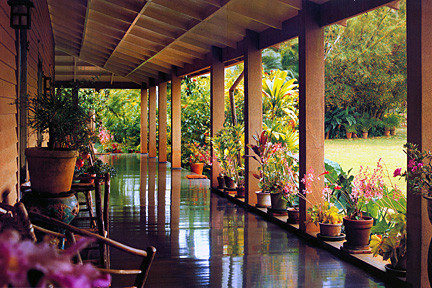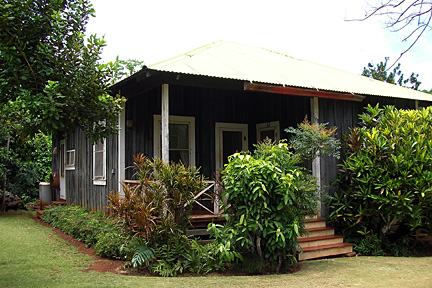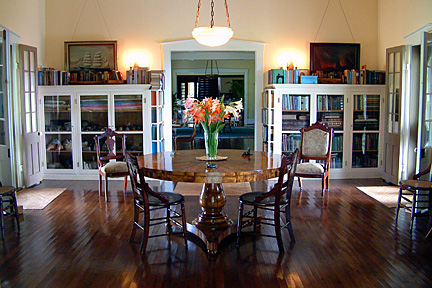
|
Hawaii’s
Back Yard |

|
Grove Farm preserves
Wilcoxes’ legacy
Walk through a family's home and you'll get a good sense of who they are by seeing how they live.
If you go ...What: Grove Farm MuseumAddress: 4050 Nawiliwili Road, Lihue, Kauai Tours: Two-hour guided tours are available at 10 a.m. and 1 p.m. Mondays, Wednesdays and Thursdays. Reservations are required. Directions to Grove Farm will be given when you make your reservation. Groups are limited to six people. Admission: $5 requested donation per person, $2 for children 12 and younger. The tour is not recommended for children under 5. Call: 808-245-3202
|
Handsome koa furniture; bookcases filled with hymnals, Bibles and other works in the Hawaiian language; glass cabinets showcasing an eclectic assortment of curios, including shells, coral, lava rocks, even a preserved Hawaiian bat -- these treasures and others reveal the family's refined taste, interest in natural history and love for the Hawaiian culture.
Grove Farm was acquired in 1864 by George Wilcox, the son of American Protestant missionaries Abner and Lucy Wilcox. Six years later, his brother Sam moved there to help manage the company's cattle and sugar operations.
George was a lifelong bachelor, but Sam and his wife, Emma, also a missionary descendant, raised six children at Grove Farm. In 1971 their youngest and last surviving child, Mabel, created a nonprofit organization to preserve the home and all of its contents as a living museum representing Hawaii's rich plantation heritage.
A registered nurse who never married, Miss Mabel lived at Grove Farm until her death in 1978 at age 96. Guided tours of the picturesque homestead, which is on both the State and National Registers of Historic Places, started two years later.

Many of the items that Kikunyo Moriwaki owned when she served as Grove Farm's laundress for 50 years remain in her cottage today, left by her children.
In its heyday, Grove Farm was alive with activity. "It was very much a working farm," says Robert Schleck, Grove Farm's director. "All the food for the Wilcoxes and their workers was raised here. They had a garden, chickens, ducks, turkeys, geese and pigs. Sam was sheriff of Kauai for 25 years, but he also ran the farm's cattle operation, so there was always fresh beef."
Tour-goers are shown prized possessions that Miss Mabel would've shown her guests, Schleck says: "She and her family had a great respect for things Hawaiian."
Displayed in a corner of the library is an impressive collection of wooden calabashes, including one made of koa that a man had been using to hold swill for his pigs. Appalled to see something so beautiful treated with such disregard, Miss Mabel's older sister, Elsie, convinced him to trade the bowl for a bucket.
Also of note are spears, sinkers, dogs' teeth anklets, necklaces made of whale bone and human hair, lomilomi massage sticks, poi pounders, ulu maika (bowling) stones and a coconut drum base. Many of the artifacts were found on Grove Farm land as it was being cleared to plant cane.
Students at Hilo Boarding School, which was established by Emma's parents, crafted much of the furniture in the home.
"The native boys learned different trades at the school, including woodwork," says Schleck. "The Wilcoxes supported the school by buying furniture the boys made. They would send a picture of a table, chair or cabinet that they liked, and the students would reproduce it for them."
Some of the family's most cherished pieces were obtained purely by chance. For instance, on a two-month trip to Asia in 1907, George, Miss Mabel and Miss Elsie visited Yokohama, Japan, where they came upon a store celebrating its grand opening.
Their driver bought them a ticket for a prize drawing, but they went on to their next destination before the winner was announced. Not long afterward, they received word that they had won the grand prize, a gorgeous black lacquer cabinet. They shipped it home to Grove Farm, where it was used to store fine linens.
Opera glasses, binoculars, spyglasses, Camel cigarettes, a cribbage board, a box of See's candy, a menorah, a music box -- in each room of the house -- little things provide big clues about the occupants' lives and loves.
Miss Mabel always kept a hatpin on her night stand. "In the evening she would put on mosquito repellent, get in bed and read an Ellery Queen mystery," Schleck says. "If strange noises scared her, she felt reassured, knowing she had the hatpin there for protection."

Three restored steam locomotives will be used to provide rides along an old cane haul route after a section of the railroad track is restored.
Cleaning at Grove Farm was structured. The main rooms were done in the morning, and each afternoon was devoted to a different chore. On Monday, attention turned to the guest cottage. Tuesday was set aside for mending, needlepoint and embroidery. The silver was polished on Wednesday, and every Thursday, the staff spruced up the trunk room, where the luggage was stored.
On Friday the kitchen received a thorough scrubbing, and on Saturday the head gardener would bring in buckets of blooms from the surrounding gardens and floral bouquets would be placed throughout the house. Sunday, the Sabbath, was reserved for God's work.
If Miss Mabel were to inspect Grove Farm today, she no doubt would be pleased; every inch of the 80-acre property is immaculate.
The tour includes stops at the two-bedroom guest cottage, which, amazingly, still has its original toilets and bathtubs; George's office, where a temperature-controlled vault contains plantation records and personal correspondence dating back more than a century; George's Spartan cottage, which was off limits to everyone when he was alive; and the cozy home of Kikunyo Moriwaki, who was Grove Farm's laundress for 50 years.
Says Schleck: "When Miss Mabel announced her museum plans, Mrs. Moriwaki said to her children, 'Take anything you want from my house after I'm gone, but give those things you don't want to Miss Mabel's museum.' The children wound up leaving basically everything, including their mother's kimonos."
Adorned with trees, shrubs and flowers of all kinds, Grove Farm's expansive grounds are a botanist's dream. If time permits, stroll through the garden and say hello to Pookie, the friendly resident pig.
"It's wonderful to see Grove Farm still thriving," says Schleck. "It's a true living museum. Our mission is not only to preserve a significant place, but to preserve memories of the special people who gave it life."

The main house's library served as George Wilcox's parlor when he moved into the old house.
Drive to restore railroad track steams ahead
A segment of the original railroad track that once transported harvested cane from Grove Farm fields to Lihue Mill three-quarters of a mile away can be seen at the entrance to the homestead.Grove Farm is spearheading a fund drive to raise $250,000 to restore a mile-long section of this original Lihue Plantation track so train rides from the mill along the east side of Nawiliwili Valley can become part of its experience. "We have three restored steam locomotives named Wainiha (built in 1915), Paulo (built in 1887) and Kaipu (built in 1925) that we will use for this activity," says Grove Farm Director Robert Schleck.
"A fourth locomotive, Waihiawa (built in 1921), has yet to be restored. When the track restoration is completed, we hope to fire up the trains and provide monthly rides along the old cane haul route."
If you'd like to help, make a check out to Waioli Corp. and mail it to P.O. Box 1631, Lihue, HI 96766. Be sure to note that you'd like your tax-deductible contribution to be earmarked for the railroad project.
E-mail to Travel Desk
[News] [Business] [Features] [Sports] [Editorial] [Do It Electric!]
[Classified Ads] [Search] [Subscribe] [Info] [Letter to Editor]
[Feedback]
